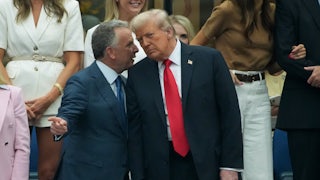There comes a time for every Republican when the irreconcilability of cutting taxes and lowering the budget deficit just won’t leave you alone. At such moments, you must cross your fingers behind your back and say: “Tax cuts pay for themselves.” In such fashion, Stephan Miran, chairman of the White House Council of Economic Advisers, lost his innocence on May 10.
A Q&A published that day (with Talmon Joseph Smith of The New York Times) posed to Miran the unavoidable question of how Congress, in crafting a budget reconciliation bill, could possibly lower the deficit while cutting taxes by $5 trillion over the next 10 years and increasing the Pentagon’s annual budget 13 percent, to nearly $1 trillion. House Speaker Mike Johnson said last week that the House would reduce tax cuts to $4 trillion and pair that with $1.5 trillion in budget cuts. But that would still increase the deficit by $2.5 trillion, more than doubling the current $1.9 trillion. And that’s without Trump’s promised exclusion of tips, Social Security benefits, and overtime pay.
Miran’s reply:
So, a couple things. One is that higher growth will make up revenue. And I think that lots of people consistently underestimate that, and are consistently wrong. There was no evidence that there was a long-run decline in tax revenues as a result of … the president’s [2017] tax cuts. Growing the economy is one of the best ways to grow revenues, and that was the experience with the president’s first tax cuts.
There is, in fact, plenty of evidence that the 2017 tax cuts in particular reduced revenue. A 2024 analysis by economists Gabriel Chodorow-Reich of Harvard, Owen M. Zidar of Princeton, and Eric Zwick of the University of Chicago, found that the corporate tax cut, which lowered the top rate from 35 percent to 21 percent, reduced corporate tax receipts by 40 percent. Combined with income tax cuts, the 2017 law reduced revenues relative to prior projections in 2018, 2019, and 2020.
Revenues started rising in 2020, and Republicans like to say that was a delayed reaction to the 2017 tax cut. It’s standard practice for supply-siders to wait years until they see unrelated economic growth, then claim it was all because of some tax cut. Thus, the Reagan tax cut of 1981 is credited with creating the “Morning in America” economic expansion of the mid-1980s and the resultant increase in tax revenue. Never mind that in 1982, Reagan signed what remains the biggest tax increase in history and that Fed Chair Paul Volcker used a brutal recession in 1981–2 to rid the economy of double-digit inflation, the absence of which did wonders for animal spirits.
The supply-side motto is “post hoc ergo propter hoc” (“after this, therefore because of this”). People like Miran work hard to ignore that Trump and his successor, Joe Biden, pumped $5 trillion into the economy to stimulate economic growth, and that that’s why tax receipts increased after Trump left office. The first stimulus bill became law in March 2020, during a very severe but very short two-month recession. The second bill was enacted in December 2020, and the third in March 2021. In the Republican mind, excess Covid stimulus created disastrous inflation—yet didn’t increase tax revenue—and it was the 2017 tax cut that revived the economy and boosted tax receipts three years after its passage, all without creating inflation. Pretty neat trick, eh?
In fact, the post-Covid boom was driven by the three stimulus bills. You can actually track this, month by month. (Incidentally, as a percentage of gross domestic product, tax receipts remain below what the Congressional Budget Office predicted in June 2017, before the Trump tax cut.) Did the stimulus bills create inflation? I remain convinced that was mostly due to supply-chain problems attributable to Covid, but sure, government spending may have played some small role too.
In explaining to The New York Times how the world works, Miran was talking not only about the 2017 tax cut but also about all tax cuts. Has a tax cut ever increased revenue?
We’ve seen that Trump’s didn’t. Neither did George W. Bush’s, which added $5.6 trillion to the deficit, according to the Center on Budget and Policy Priorities. Neither did Reagan’s. As David Wessel of the Brookings Institution pointed out in 2017, the 1981 Reagan tax cut reduced revenue by about 9 percent for a couple of years, prompting Reagan to hike taxes not only in 1982 but also in 1983, 1984, and 1987.
Some people say that President John F. Kennedy’s tax cut, enacted by Lyndon Johnson, yielded a net gain in tax revenue by dropping the top rate from 91 percent to 70 percent. If Miran wants to argue that I won’t dispute him. But anybody who argues this has to concede that an economy can boom (as it did, enviably, from the mid-to-late 1960s) with a top marginal tax rate nearly double what we have today.
Through the 1920s, under three Republican presidents, Treasury Secretary Andrew Mellon dropped the top marginal rate from 73 percent (on income above $1 million, or $23 million in current dollars) to 25 percent. Mellon also repealed a gift tax and halved the inheritance tax, keeping the world altogether too safe for his toxic billionaire descendants Richard Mellon Scaife and Timothy Mellon. The economy, of course, boomed, and there remains today a small but hardy cult of Mellon-and-Calvin-Coolidge devotees who say tax cuts are the reason why. I’ll grant this was a rare instance when the top rate was very high and then, suddenly, very low. If a supply-side tax cut can’t increase tax revenue here, it can’t do it anywhere. Maybe it did.
What I’m more inclined to remember about the 1920s, though, is that it coincided with the most spectacular convergence of newly popularized technologies the world had ever seen (automobiles, radio, airplanes, motion pictures, telephones, vacuum cleaners, frozen food, etc.). I can’t conceive that a higher top marginal tax rate could have held back such revolutionary wonders. We saw nothing like the 1920s rush of technological change during the century that followed, even after marginal income tax rates tumbled. The computer revolution of the 1980s and 1990s was swell, but when compared to the 1920s it was a blip.
Some economists say we’ll never again see change as rapid as it was in the 1920s. I think such things are pretty hard to predict. Anyway, the other thing to remember about the 1920s is that when they stopped Roaring, they crashed—creating the worst economic depression in American history.
The historical trail goes cold before the 1920s because the income tax dates only to 1913. (I have not made a study of the Civil War–era income tax, which was temporary.) If the supply-side view of things were correct, what was by definition an infinite increase in the top marginal tax rate in 1913 (from zero percent to 7 percent on income over $500,000, or $16 million in 2025 dollars) should have made the wild economic growth of the 1920s impossible. But it happened. Go figure.










